Task 26 The task requires to draw up a plan of the text, highlighting its main relatively complete semantic fragments and title each of them. An outline is a clear sequential presentation of parts of the content of the text in brief formulations that reflect the theme and / or main idea of the corresponding fragment. To complete the task, you must: - read the text carefully, - understand its content, - understand the topic, - identify the main ideas of the text. The names of the paragraphs of the plan should not fully reproduce individual phrases of the text. It is necessary to highlight the main idea of each fragment and briefly formulate it. The number of selected fragments can be different.
Types of Plans A plan can be simple or complex. The plan can be drawn up in a denominative form (no verbs). The plan can be drawn up in question or thesis form. - The question plan is written in the form of questions to the text; Each paragraph of the text corresponds to one question. - Thesis plan consists of theses of the verb structure. The thesis is a briefly formulated main provision of a paragraph of text, lecture, report, etc.
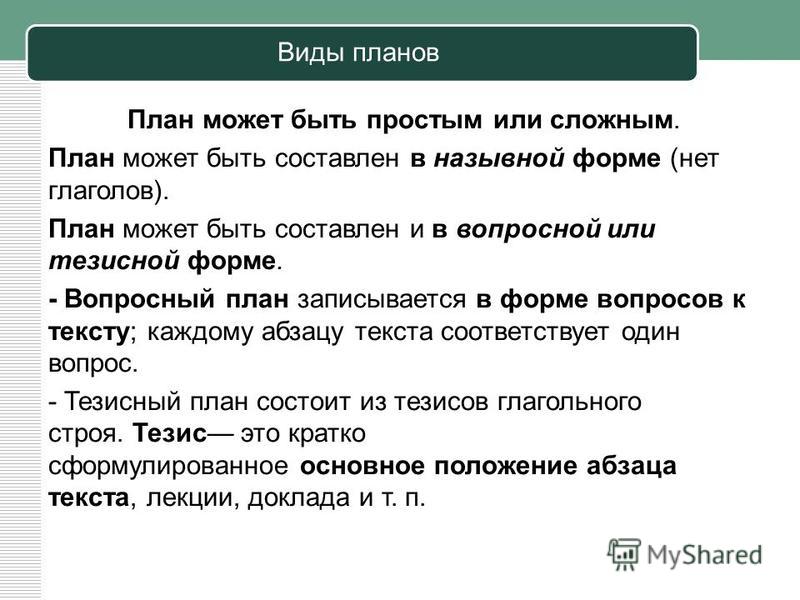
Criteria for assessing the task 1. The ability to identify the main semantic fragments of the text, to formulate their names (points of the plan) is assessed. 2. Maximum score for completing the task - 2 points. 3. Expert in evaluating performance given task decides: is the structure of the text correctly defined by the graduate (are all the semantic parts of the text highlighted; are there any “extra” missing in the text semantic parts; are the points of the plan related in meaning); how accurately the content of the text is conveyed in the titles of the points of the plan (how accurately the points of the plan reveal the main idea of the corresponding fragment, the author’s thought; do they correspond common logic disclosing the content of the text). 4. If all the semantic parts of the text are highlighted, the title reflects the main ideas of the text logically and completely - 2 points are given. 5. If the student correctly identified more than half of the semantic fragments of the text and reflected the main ideas of the relevant parts of the text in the names (paragraphs of the plan), then 1 point is given. 6. The main fragments of the text are not highlighted OR the names of the selected fragments (points of the plan) do not correspond to the main idea of the corresponding parts of the text, being quotations from the corresponding fragment, OR the answer is incorrect, 0 points are given
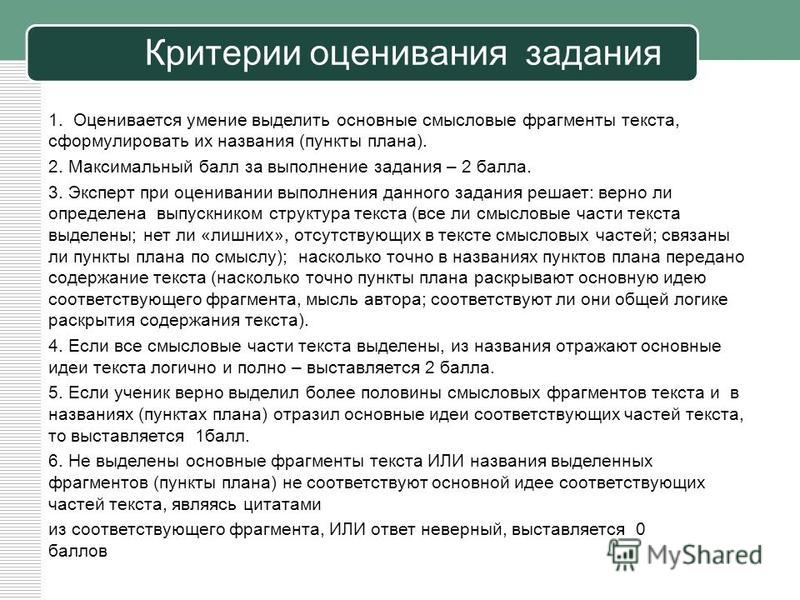
Task 27 The second task involves the extraction of information presented in the text explicitly. Tasks may contain requirements: find any two (three) definitions in the text (explanations, reasons, characteristics, etc.); find answers to 2-3 questions in the text; find evidence (arguments, etc.) in the text that the author cites in support of some idea; fill in the gaps in the table. The ability to extract information from the text is tested and evaluated. For example, bringing one position instead of the required three or four indicates an insufficient level of possession of this skill. Please note: The task is directly related to the text. Examinee's reasoning, not related to the content of the text, cannot be considered the correct answer. If the answer is reduced to reasoning that is not directly related to the text, then it is scored 0 points. The maximum score for completing the task is 2 points.
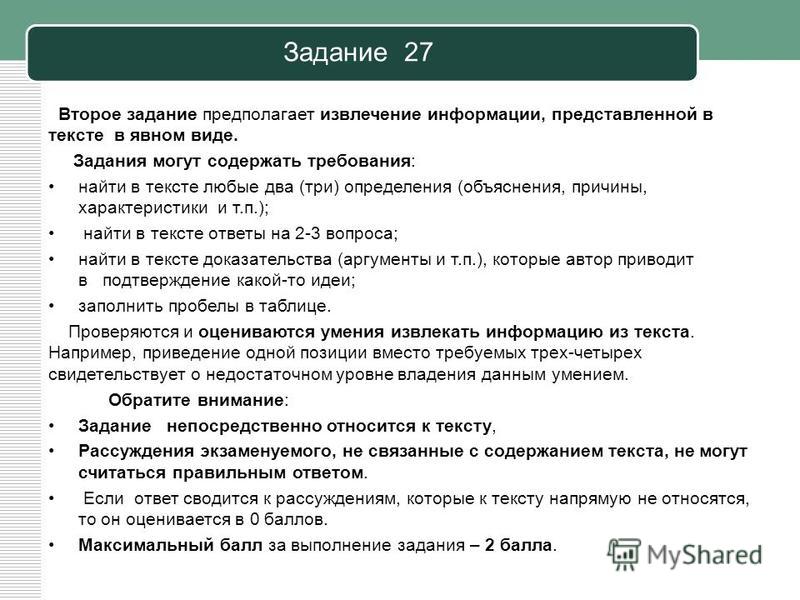
Task 28 The task involves a transformative reproduction or interpretation of the information contained in the text. This type tasks has several models: determine what is a fact, determine its causes; establish the consequences of the described social phenomenon; explain the position (opinion, point of view, etc.) of the author and give his arguments (explanations, evidence, examples, etc.); evaluate the role of certain factors, etc. In the graduate's answer, the required information can be given in the form of a direct quotation from the text, and details can be omitted and only a fragment of the phrase is given. Information can also be given in the form of a paraphrase close to the text. The reasoning of the examinee, not directly related to the content of the text, cannot be considered the correct answer. If the answer is reduced to only such reasoning, it is estimated at 0 points. The task, like the previous task 27, also directly relates to the text, but requires its interpretation and involvement of the knowledge of the course. You should carefully read what and in what quantity you need to name and what sources of information to involve (only text or knowledge of the course, personal experience, data public life).

Task 29 The task involves going beyond the content of the text and attracting knowledge social science course, facts of public life or personal social experience graduate. An assignment can have two parts (for example, an explanation and examples). This type of tasks has several models of conditions and requirements: Using the facts of social life and personal social experience, name three manifestations of a phenomenon ... Using the content of the text, knowledge of the course and personal social experience, give three confirmations ... (give three explanations) ... Using facts public life and personal experience, confirm with three examples ... (give three examples, confirm with three concrete examples) ... Based on social science knowledge and personal social experience, make three assumptions ... Using the content of the text, social science knowledge and facts of social life, give two examples ... and briefly explain each example ... Using the content of the text, social science knowledge and personal social experience, explain three situations ... Illustrate the idea of the text with three examples ... (illustrate any three characteristics given in the text with specific examples) ... Based on the author's text, formulate three recommendations ...
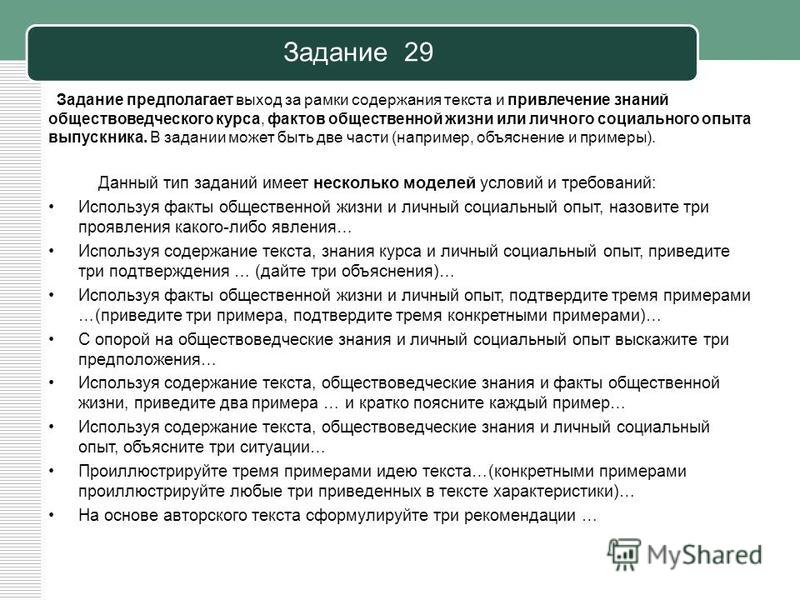
Criteria for evaluating tasks 29. What are the requirements for the implementation of such tasks? Firstly, the accuracy and correctness of the facts presented, their compliance with the theoretical provisions given in the task; Secondly, reasoning should concretize the essence of the given in the task theoretical position, the logical and meaningful correctness of these reasonings is evaluated. The provisions or concepts that need to be specified, as a rule, are general, abstract character(such is the specific social science knowledge). Examples may be facts of the past and present, gleaned from one's own experience or that have become publicly known; real events and simulated situations. The maximum score is 3 points.

Task 30 The task, which, as a rule, has an independent detailed condition, tests the ability to apply knowledge gleaned from the source social information to solve a specific problem. The task involves using information from the text to comprehend and explain actual facts and processes real life, practical life situations. The correct answer must contain the following elements: answer to the question text fragment The task is evaluated as follows: An explanation is given, a text fragment is given. - 2 points. An explanation is given OR a piece of text is given. -1 point. The answer is incorrect. - 0 points. Tasks have two levels of requirements: the first refers directly to the situation formulated in the condition; the second - focuses on the search for information to solve the problem in the proposed source. Variants use different models terms: problem situation, social fact, statistical data, problem statement, etc.

Examples of tasks 30 Condition of the task - a problem situation Citizens have submitted an application for registration of marriage to the registry office. The bride immediately demanded that the groom provide her material support. The groom refused, citing the fact that the marriage had not yet been concluded. Is the groom's refusal legal? Explain your answer. What piece of text can help you explain? The task condition is a social fact In state Z, the share of rural residents has significantly decreased over the past 20 years, which has had a negative impact on the development of the agricultural sector. In this regard, a law was passed prohibiting the inhabitants of villages and villages from leaving for the city. Rate this law from a position of knowledge natural rights person. Provide a piece of text that can justify your assessment. The maximum score for completing the task is 2 points.

Task 31 The task involves the formulation and argumentation by the graduate of his own judgment (or the author's position, opinion, etc.) on the current problematic issue public life. This building is directly related to the content of the text, but involves consideration of its individual provisions from a different perspective. The assignment to the text is constructed in such a way that in his answer the student can both agree with the given point of view and refute it. The correct answer must contain the following elements: student's opinion: agreement or disagreement with the stated position; arguments (explanations), in case of agreement or disagreement.
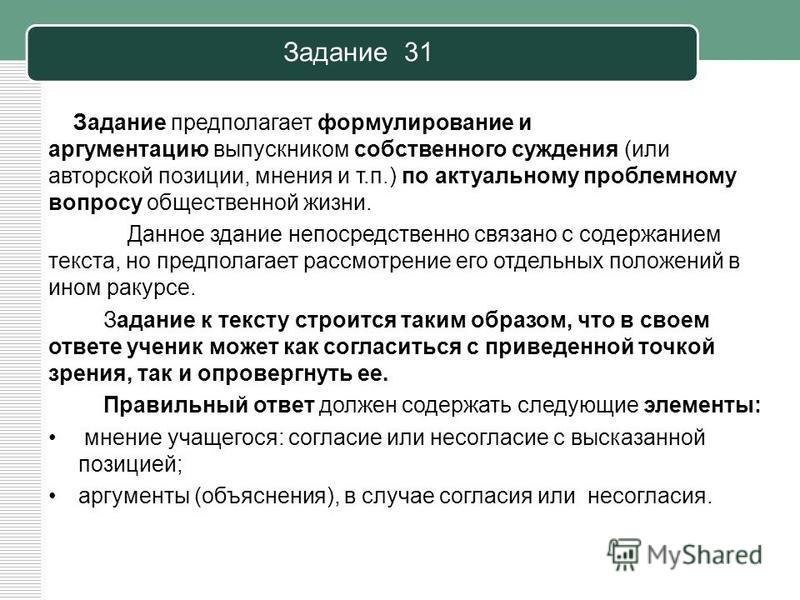
Criteria for evaluating assignment 31 - The student's opinion is expressed, two arguments are given. - 2 points. - The student's opinion is expressed, one argument is given OR the student's opinion is not expressed, but it is clear from the context, two arguments are given. - 1 point. - The student's opinion is expressed, no arguments are given OR the student's opinion is not expressed, but it is clear from the context, one argument is given OR the answer is incorrect. - 0 points. Evaluated: - meaningful completeness, - logical validity own position student, - the variety of arguments given by him. Arguments can be knowledge, facts, examples gleaned from the course, from media reports, from personal social experience. This type of tasks has another model of the condition and the requirements arising from it: - Based on the text and social science knowledge, give two arguments (explanations) in defense of the position (opinion, point of view, etc.) of the author. Maximum score - 2:

Note to students Use of the texts included in KIMS Unified State Examination in social studies lessons In the learning process, it is necessary to acquaint students with texts various kinds, showing their originality and characteristic features. This is not, of course, a serious textual analysis. It is enough to accustom students to start working with the text by “recognizing” its species, this will facilitate its interpretation and analysis. The “recognition effect”, as practice shows, is extremely important for successful implementation examination tasks in relation to the tasks of part C. It is appropriate to use the recommendations described in the methodological literature. It should be remembered: if the main statement in the text, the argument of any truth, is most likely scientific text; if the norms of behavior (prohibitions, prescriptions, opportunities) are set out, this is most likely legal document; if the basis of the text are value judgments, the attitude to something is clearly shown; this is a journalistic text; if quantitative indicators are presented that reflect the state or development trend of an object, these are static materials; if the text contains assessments of the state of society and forecasts, promises, plans for improvement, this is most likely a political document; if only facts are stated (a description of something, some actions or someone's judgments is given), these are informational materials” (L.N. Bogolyubov, E.L. Rutkovskaya).

How to work with the text on the exam 1. How to start working with the text? It is necessary to carefully read both the text and the questions to it. "Solid" reading is useful in that it makes it possible to orientate in the text, preliminarily (not always explicitly, more often in a filmed form) determine its structure, note key points, correlate its content with tasks and questions. It is important in the process of preliminary reading to clearly determine to which content line of the course of social science the proposed text belongs. Such a correlation is necessary because, as has been noted more than once, some tasks involve the involvement of contextual knowledge. 2. Whether it is necessary to determine main idea text? It is not necessary to look for exact formulations (unless, of course, among the tasks there is one that directly prescribes to determine the main idea of the author); it is enough to answer the question: “What is the text talking about?”.

How to work with the text on the exam 3. In what order should I answer the questions? General principle easy to answer in the order in which they are presented in the paper. It is sometimes impossible to complete the subsequent task if the answer to the previous question is not found. However, if there are difficulties, you should not stop working on the text. Each task is evaluated, and even a not very convincing answer may contain the right elements that deserve extra point. 4. How to find out for yourself whether to look for the answer in the text or do you need to remember what was studied in the lessons? Read the assignment carefully. It gives the appropriate instructions: find in the text; what the author says what signs does the author name; Based on the knowledge of the course and your own experience, describe; specify the opinion of the author, based on knowledge of the course. The conclusion is obvious: you need to carefully read the task.
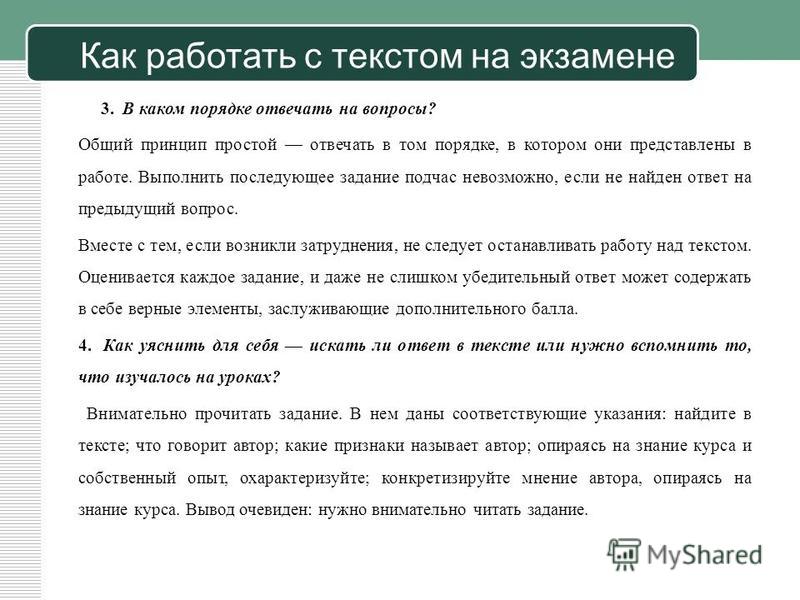
How to work with the text on the exam 5. What should I pay attention to when completing assignments? Important: read the assignment carefully; understand what exactly is required for a successful response; understand what parts the task consists of; try to complete all the tasks; if you can answer only part of the question, be sure to write down the answer (each element of the answer is scored, incomplete, but the correct answer will bring you extra points); do not go beyond the scope of the question, do not try to write everything you know about the problem, do not evaluate the author's opinion and do not seek to express your point of view, if this is not expressly provided for by the task.
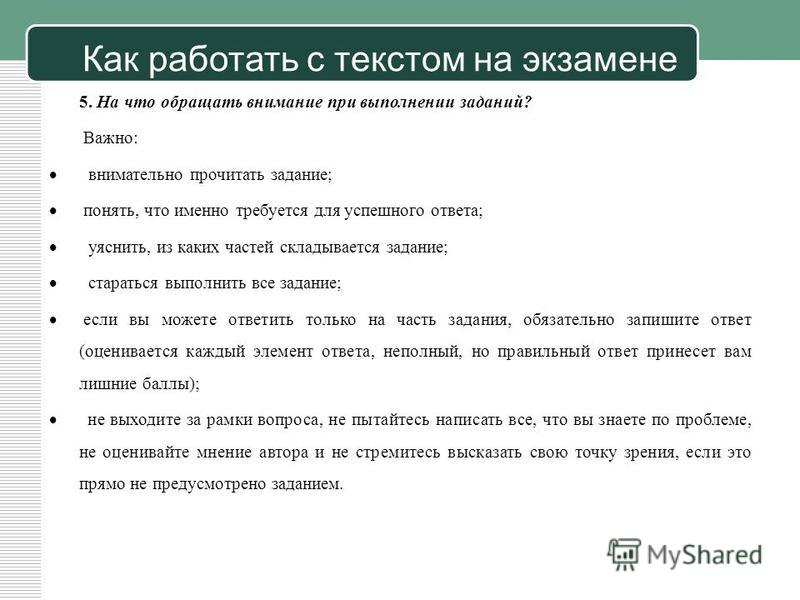
Probably everyone who was preparing to take the GIA in society decided trial options, demo version. And everyone saw that the answer to the task "C1" usually contains 3-4 theses from the text, more is very rare. The student concludes that one should strive to highlight only three or four fragments. Pay attention to the postscript: "Other answers are allowed that do not distort the meaning ...". The bottom line is that the “C” part is checked by a person, not a machine, you don’t have to adapt to someone’s way of thinking. The more details you highlight, parts of the text, the more accurate your plan is, the better. Do not be afraid that because of this you will get a lower rating.
2 step
We start work. First of all, you need to read the text and weed out the unnecessary. As a rule, in each paragraph of the text there is at least one thought; in social science there are often several of them. But there are paragraphs that simply express the opinion of the author, or that are used to create emotional coloring. We do not need such paragraphs, select them.
3 step
We now turn to the process of planning the text itself. First read the paragraph, then find out: one thought is concentrated in it or two or more. If there are two or more, then in no case should you write several theses in one paragraph of the plan. For example, the wrong paragraph plan:
1. Suffrage in history and its transformation in Russia.
Correct example:
1. Suffrage in history
2. transformations suffrage in Russia.
Maybe if you write as in the first example, you will be blown away, but why take the risk?
4 step
Once you've covered the first paragraph, move on to the second. I repeat: paragraphs written for emotional coloring are not included in the plan. It is also not necessary to single out both the "Introduction" and "Conclusion" parts. This is clearly redundant.
